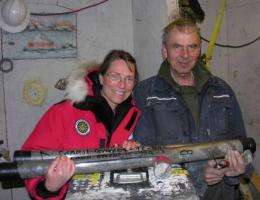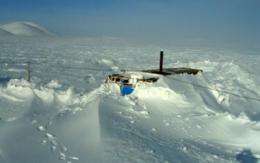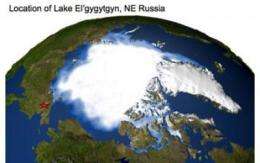Arctic climate more vulnerable than thought, maybe linked to Antarctic ice-sheet behavior

First analyses of the longest sediment core ever collected on land in the terrestrial Arctic, published this week in Science, provide documentation that intense warm intervals, warmer than scientists thought possible, occurred there over the past 2.8 million years.
Further, these extreme warm periods correspond closely with times when parts of Antarctica were ice-free and also warm, suggesting strong inter-hemispheric climate connectivity. "The polar regions are much more vulnerable to change than we thought before," say the project's Co-Chief scientists Martin Melles of the University of Cologne, Germany, Julie Brigham-Grette of the University of Massachusetts Amherst, USA, and Pavel Minyuk of Russia's North-East Interdisciplinary Scientific Research Institute in Magadan.

The data reported come from analyzing sediment cores collected in 2009 from under ice-covered Lake El'gygytgyn in the northeast Russian Arctic. "Lake E" was formed 3.6 million years ago when a huge meteorite hit the Earth and blasted out an 11-mile (18 km) wide crater. It has been collecting layers of sediment ever since. Moreover, the meteorite luckily hit one of the few areas in the Arctic not eroded by continental glaciers, leaving the thick sediment record remarkably undisturbed and continuous. Consequently, cores from Lake E reach back in geologic time nearly 30 times farther than Greenland ice cores covering the past 110,000 years.
The sediment cores from Lake El´gygytgyn reflect the climatic and environmental history of the Arctic with great sensitivity. The physical, chemical and biological properties of the sediments match the glacial/interglacial pattern known globally for the ice ages. However, it is conspicuous that some warm phases are exceptional, marked by extraordinary high biological activity in the lake, well above the background of rather regular climate cycles.
In order to quantify the climate differences associated with the variable interglacial intensities, four warm phases were investigated in detail: the two youngest, "normal" interglacials, since 12,000 years and about 125,000 years ago, and two of the "super" interglacials, about 400,000 and about 1.1 million years ago. According to pollen-based climate reconstructions, summer temperatures and annual precipitation during the super interglacials were about 4 to 5 degrees C warmer and about 12 inches (300 mm) wetter than during normal interglacials. The super interglacial climates suggest that it's virtually impossible for the Greenland's ice sheet to have existed in its present form at those times.
Simulations using a state-of-the-art climate model show that the high temperature and precipitation during the super interglacials cannot be explained by Earth´s orbital parameters or variations in atmospheric greenhouse gases alone, which geologists typically see driving the glacial/interglacial pattern during ice ages. This suggests additional climate feedbacks are at work. The scientists suspect the trigger for intense interglacials might be in Antarctica.
Earlier work by the international ANDRILL program discovered recurring intervals when the West Antarctic Ice Sheet melted. The current study shows that some of these events match remarkably well with the super interglacials in the Arctic.

The authors discuss two scenarios for future testing that could explain the associated inter-hemispheric climate coupling. First, reduced glacial ice cover and loss of ice shelves in Antarctica could have limited formation of cold bottom water masses that flow into the north Pacific and well up to the surface, resulting in warmer surface waters, higher temperatures and increased precipitation on nearby land.
Alternatively, disintegration of the West Antarctic Ice Sheet likely led to a significant global sea level rise and allowed more warm surface water to penetrate into the Arctic Ocean through the Bering Strait.
"The exceptional climate warmings in the Arctic and the obvious interhemispheric interdependencies were not known before our studies", the Co-Chief scientists summarize. "The data are of global significance, taking strong indications for an ongoing collapse of ice shelves around the Antarctic Peninsula and margins of the West Antarctica Ice Sheet and its potential acceleration in the near future – in this respect the past could be the key to the future".
More information: "2.8 Million Years of Arctic Climate Change from Lake El’gygytgyn, NE Russia," by M. Melles et al., Science, 2012.
Journal information: Science
Provided by University of Massachusetts Amherst


















